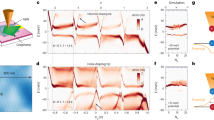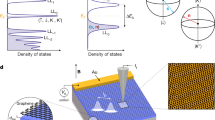Abstract
Electrons in a single sheet of graphene behave quite differently from those in traditional two-dimensional electron systems. Like massless relativistic particles, they have linear dispersion and chiral eigenstates. Furthermore, two sets of electrons centred at different points in reciprocal space (‘valleys’) have this dispersion, giving rise to valley degeneracy. The symmetry between valleys, together with spin symmetry, leads to a fourfold quartet degeneracy of the Landau levels, observed as peaks in the density of states produced by an applied magnetic field. Recent electron transport measurements have observed the lifting of the fourfold degeneracy in very large applied magnetic fields, separating the quartet into integer1,2,3,4 and, more recently, fractional5,6 levels. The exact nature of the broken-symmetry states that form within the Landau levels and lift these degeneracies is unclear at present and is a topic of intense theoretical debate7,8,9,10,11. Here we study the detailed features of the four quantum states that make up a degenerate graphene Landau level. We use high-resolution scanning tunnelling spectroscopy at temperatures as low as 10 mK in an applied magnetic field to study the top layer of multilayer epitaxial graphene. When the Fermi level lies inside the fourfold Landau manifold, significant electron correlation effects result in an enhanced valley splitting for even filling factors, and an enhanced electron spin splitting for odd filling factors. Most unexpectedly, we observe states with Landau level filling factors of 7/2, 9/2 and 11/2, suggestive of new many-body states in graphene.
This is a preview of subscription content, access via your institution
Access options
Subscribe to this journal
Receive 51 print issues and online access
$199.00 per year
only $3.90 per issue
Buy this article
- Purchase on Springer Link
- Instant access to full article PDF
Prices may be subject to local taxes which are calculated during checkout





Similar content being viewed by others
References
Zhang, Y. et al. Landau-level splitting in graphene in high magnetic fields. Phys. Rev. Lett. 96, 1–4 (2006)
Jiang, Z., Zhang, Y., Stormer, H. & Kim, P. Quantum Hall states near the charge-neutral Dirac point in graphene. Phys. Rev. Lett. 99, 106802 (2007)
Abanin, D. A. et al. Dissipative quantum Hall effect in graphene near the Dirac point. Phys. Rev. Lett. 98, 196806 (2007)
Gusynin, V. P. & Sharapov, S. G. Unconventional integer quantum Hall effect in graphene. Phys. Rev. Lett. 95, 146801 (2005)
Bolotin, K. I., Ghahari, F., Shulman, M. D., Stormer, H. L. & Kim, P. Observation of the fractional quantum Hall effect in graphene. Nature 462, 196–199 (2009)
Du, X., Skachko, I., Duerr, F., Luican, A. & Andrei, E. Y. Fractional quantum Hall effect and insulating phase of Dirac electrons in graphene. Nature 462, 192–195 (2009)
Nomura, K. & MacDonald, A. Quantum Hall ferromagnetism in graphene. Phys. Rev. Lett. 96, 256602 (2006)
Alicea, J. & Fisher, M. Graphene integer quantum Hall effect in the ferromagnetic and paramagnetic regimes. Phys. Rev. B 74, 075422 (2006)
Yang, K., Das Sarma, S. & MacDonald, A. Collective modes and skyrmion excitations in graphene SU(4) quantum Hall ferromagnets. Phys. Rev. B 74, 1–8 (2006)
Goerbig, M. O., Moessner, R. & Doucot, B. Electron interactions in graphene in a strong magnetic field. Phys. Rev. B 74, 161407 (2006)
Abanin, D., Lee, P. & Levitov, L. Randomness-induced XY ordering in a graphene quantum Hall ferromagnet. Phys. Rev. Lett. 98, 1–4 (2007)
Kamerlingh Onnes, H. The resistance of pure mercury at helium temperatures. Comm. Phys. Lab. Univ. Leiden. 120b, (1911)
Klitzing, K. V., Dorda, G. & Pepper, M. New method for high-accuracy determination of the fine-structure constant based on quantized Hall resistance. Phys. Rev. Lett. 45, 494–497 (1980)
Tsui, D. C., Stormer, H. L. & Gossard, A. C. Two-dimensional magnetotransport in the extreme quantum limit. Phys. Rev. Lett. 48, 1559–1562 (1982)
Miller, D. L. et al. Observing the quantization of zero mass carriers in graphene. Science 324, 924–927 (2009)
Li, G., Luican, A. & Andrei, E. Scanning tunneling spectroscopy of graphene on graphite. Phys. Rev. Lett. 102, 1–4 (2009)
Dial, O. E., Ashoori, R. C., Pfeiffer, L. N. & West, K. W. Anomalous structure in the single particle spectrum of the fractional quantum Hall effect. Nature 464, 566–570 (2010)
Hass, J. et al. Why multilayer graphene on 4H-SiC(0001-bar) behaves like a single sheet of graphene. Phys. Rev. Lett. 100, 125504 (2008)
Mele, E. J. Commensuration and interlayer coherence in twisted bilayer graphene. Phys. Rev. B 81, 161405 (2010)
Miller, D. L. et al. Structural analysis of multilayer graphene via atomic moiré interferometry. Phys. Rev. B 81, 125427 (2010)
Ando, T. & Uemura, Y. Theory of oscillatory g factor in an MOS inversion layer under strong magnetic fields. J. Phys. Soc. Jpn 37, 1044–1052 (1974)
Smith, A. P., MacDonald, A. H. & Gumbs, G. Quasiparticle effective mass and enhanced g factor for a two-dimensional electron gas at intermediate magnetic fields. Phys. Rev. B 45, 8829–8832 (1992)
Dial, O. E., Ashoori, R. C., Pfeiffer, L. N. & West, K. W. High-resolution spectroscopy of two-dimensional electron systems. Nature 448, 176–179 (2007)
Zhang, C. & Joglekar, Y. Wigner crystal and bubble phases in graphene in the quantum Hall regime. Phys. Rev. B 75, 1–6 (2007)
Wang, H., Sheng, D., Sheng, L. & Haldane, F. Broken-symmetry states of Dirac fermions in graphene with a partially filled high Landau level. Phys. Rev. Lett. 100, 1–4 (2008)
Rezayi, E., Haldane, F. & Yang, K. Charge-density-wave ordering in half-filled high Landau levels. Phys. Rev. Lett. 83, 1219–1222 (1999)
Lilly, M., Cooper, K., Eisenstein, J., Pfeiffer, L. & West, K. Evidence for an anisotropic state of two-dimensional electrons in high Landau levels. Phys. Rev. Lett. 82, 394–397 (1999)
Nayak, C., Simon, S. H., Stern, A., Freedman, M. & Das Sarma, S. Non-Abelian anyons and topological quantum computation. Rev. Mod. Phys. 80, 1083–1159 (2008)
Eisenstein, J. P. & MacDonald, A. H. Bose–Einstein condensation of excitons in bilayer electron systems. Nature 432, 691–694 (2004)
Berger, C. et al. Ultrathin epitaxial graphite: 2D electron gas properties and a route toward graphene-based nanoelectronics. J. Phys. Chem. B 108, 19912–19916 (2004)
Acknowledgements
We thank N. Zhitenev for discussions, S. Blankenship, A. Band and F. Hess for their technical contributions to the construction of the millikelvin scanning probe microscopy system, V. Shvarts for his advice on cryogenics and U. D. Ham for instructions on making silver probe tips. This work was supported in part by the Korea Research Foundation Grant funded by the Korean Government (MOEHRD) (KRF- 2006-214-C00022), the NSF (DMR-0820382 [MRSEC], DMR-0804908, DMR-0606489), the Welch Foundation and the Semiconductor Research Corporation (NRI-INDEX programme).
Author information
Authors and Affiliations
Contributions
Y.J.S, A.F.O, Y.K. and J.A.S designed and constructed the millikelvin scanning probe microscopy system. The graphene scanning tunnelling microscopy/scanning tunnelling spectroscopy measurements were performed by Y.J.S, A.F.O and J.A.S. The graphene sample was grown by Y.H and W.A.d.H., and the surface was prepared and characterized by D.B.T and P.N.F. A theoretical analysis of the epitaxial graphene multilayer system was performed by H.M., S.A., M.D.S and A.H.M.
Corresponding author
Ethics declarations
Competing interests
The authors declare no competing financial interests.
Supplementary information
Supplementary Figures
The file contains Supplementary Figures 1-2 with legends. (PDF 365 kb)
Rights and permissions
About this article
Cite this article
Song, Y., Otte, A., Kuk, Y. et al. High-resolution tunnelling spectroscopy of a graphene quartet. Nature 467, 185–189 (2010). https://doi.org/10.1038/nature09330
Received:
Accepted:
Issue Date:
DOI: https://doi.org/10.1038/nature09330
This article is cited by
-
Atomically engineering metal vacancies in monolayer transition metal dichalcogenides
Nature Synthesis (2024)
-
Determining the temperature of a millikelvin scanning tunnelling microscope junction
Communications Physics (2023)
-
Broken symmetries and excitation spectra of interacting electrons in partially filled Landau levels
Nature Physics (2023)
-
Recent progresses of quantum confinement in graphene quantum dots
Frontiers of Physics (2022)
-
Symmetry-broken Chern insulators and Rashba-like Landau-level crossings in magic-angle bilayer graphene
Nature Physics (2021)
Comments
By submitting a comment you agree to abide by our Terms and Community Guidelines. If you find something abusive or that does not comply with our terms or guidelines please flag it as inappropriate.



